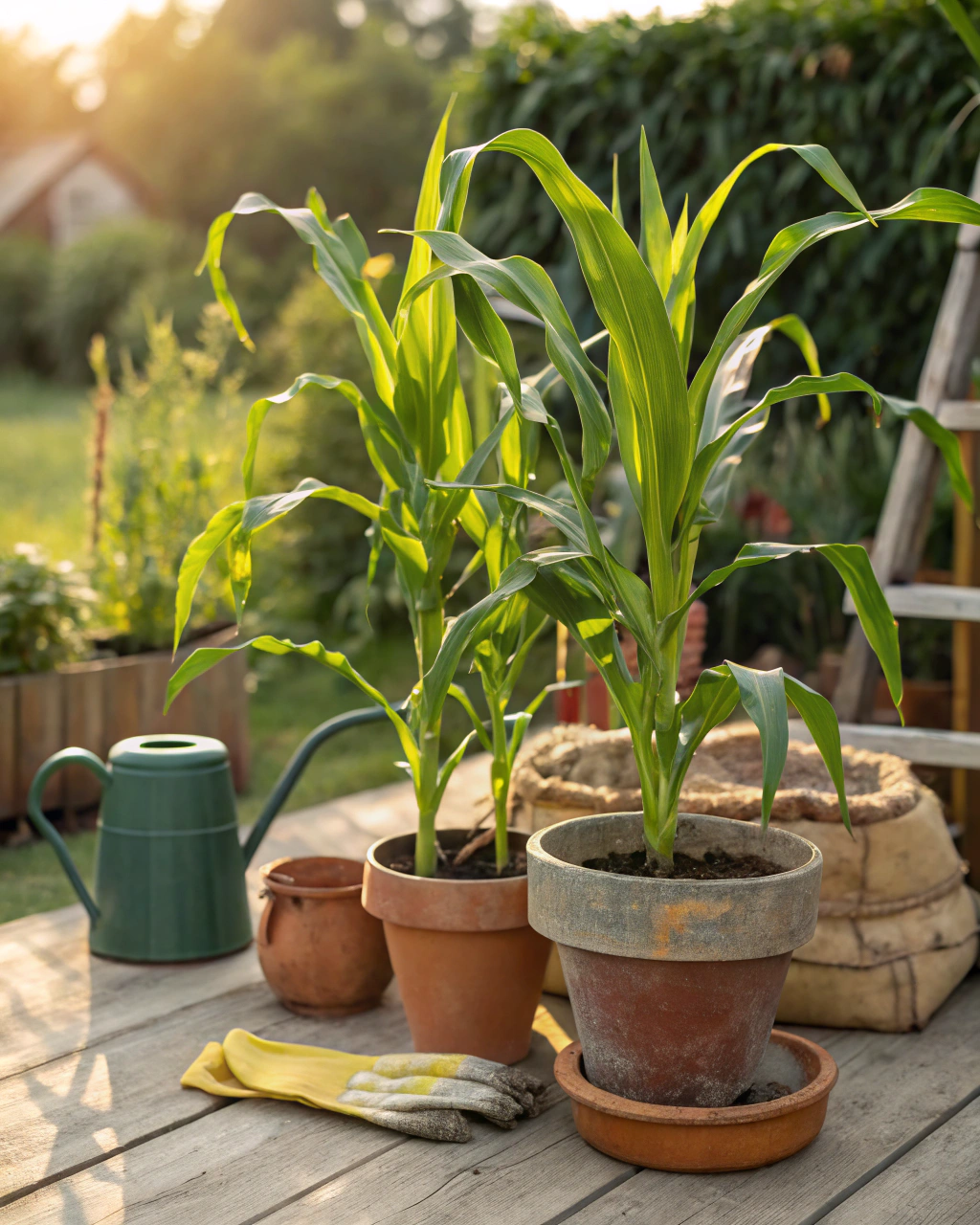Why Grow Sweet Corn in Containers?
Sweet corn is one of summer’s simplest pleasures—the warm sunshine, the fresh green stalks, and eventually those juicy, summery ears packed with sweetness. You might think you need a large garden patch to grow corn, but you don’t. You can enjoy homegrown corn even on a small balcony, patio, or doorstep. Growing sweet corn in containers opens up fresh possibilities for city dwellers and anyone short on space. Plus, there’s nothing quite like picking your own corn at the peak of ripeness—bursting kernels, sweet aroma, and that satisfying crunch. Follow these clear, practical steps and you’ll be rewarded with delicious summer treats, fresh from your own pots. Trust me: it’s easier than it looks, and you can do it.
Getting Ready — What You’ll Need
Here’s your container-growing toolkit: every item matters in giving your sweet corn the best start.
- Container: At least 30 cm (12 in) deep and 30 cm diameter per corn stalk. Corn roots grow deep, so size matters. Square or round pots both work; choose wide pots for multiple plants. (If your area is really hot, clay pots keep roots cooler.)
- Drainage: Containers must have several drainage holes. Good drainage prevents root rot.
- Soil: Use a loose, well-draining mix—about 70% loam, 20% rich compost, and 10% coarse sand or perlite. This balances nutrients and airflow. Avoid heavy, compacted soils.
- Fertilizer: Use a balanced, low-nitrogen fertilizer (NPK ratio 5-10-10) to promote sturdy stalks and sweet ears without excess leaf growth.
- Light: Sweet corn needs 6–8 hours of direct sunlight every day. A south- or west-facing spot is ideal.
- Seeds: Choose varieties suited for containers and your climate. Examples: ‘Early Sunglow’ or ‘Sugar Buns’—compact, early-maturing, and sweet.
- Watering tools: A watering can with a fine rose or a gentle hose sprayer. Consistent moisture is essential.
- Garden gloves, trowel, and hand fork: For soil mixing, planting, and occasional loosening.
For low-budget or eco-friendly options, re-use food-grade containers (ensure drainage), make your own compost, or use natural fertilizers like seaweed extracts. Just make sure your pots are sturdy and your soil stays loose and rich.
Step-by-Step — How to Grow Sweet Corn in Pots
1. Preparing Your Pot
Start by thoroughly cleaning your pot to avoid diseases—wash it with warm, soapy water and rinse well. Place a drainage layer of about 3–5 cm (1–2 in) of gravel or broken pottery shards at the bottom to keep water moving. Next, fill your pot with your prepared soil mix, packing gently but not compacting. The soil should feel like a wrung-out sponge—moist but not soggy.
Why? Drainage prevents waterlogging, which causes root rot. Loose soil allows air to reach roots, giving them space to breathe and expand. Avoid filling the pot too tightly; compacted soil blocks air and water and stunts growth. Also, never forget holes for drainage—no holes equals trapped water and dead roots.
2. Sowing or Planting
Sweet corn seeds are large and benefit from a little prep. Soak your seeds in warm water overnight to soften the tough outer shell; this helps germination.
Plant your seeds at a depth of about 2.5 cm (1 in) in the soil. Space seeds at least 15 cm (6 in) apart in each pot if planting more than one; this lets roots spread and ensures good airflow.
The ideal soil temperature for germination is around 18–24°C (65–75°F). You’ll notice sprouting within 7–10 days. When the soil feels warm and you see early shoots, you’re on the right track.
Pro tip: Before sowing, scratch the seed surface lightly with fine sandpaper. This scarification helps water penetrate the tough coating and speeds up sprouting.
3. Watering and Sunlight
Water deeply right after sowing—enough to moisten all the soil but never flood it. During growth, water about 2–3 times per week, depending on heat and wind. When you water, touch the soil—it should feel moist but not wet, never muddy or sticky.
If you experience very hot, dry, or windy conditions, group your pots close together to conserve moisture and reduce evaporation. Mulching around the stalks with straw or leaves helps keep the soil cool and hydrated. In extremely sunny spots, partial afternoon shade helps prevent scorching.
Sweet corn thrives on full sun—aim for at least 6–8 hours every day. If you live in cloudier areas, consider supplementing with a grow light or relocating pots to the brightest spot available.
4. Feeding and Maintenance
Fertilize every 3–4 weeks with a low-nitrogen fertilizer to encourage ears rather than excessive leafy growth. Follow package instructions but typically one tablespoon of fertilizer per pot mixed into the top soil is enough.
Once seedlings sprout, thin slightly if needed—remove weaker stalks to leave only the strongest one or two plants per pot. This concentrates nutrients and space for better ears.
Occasionally check soil aeration by gently loosening the top 1–2 cm (0.5–1 in) with a hand fork to prevent crusting. Avoid walking on the pot or compacting soil around the roots.
Look out for nutrient imbalances: if leaves turn pale green to yellow, that points to nitrogen or iron deficiency. If leaves curl or scorch, you may be watering too much or the pot may not be draining well.
Remember: “The secret is not more work — it’s regular care and observation.” From experience, this simple routine brings the best results.
5. Troubleshooting While They Grow
Yellow leaves? Usually excess nitrogen. Swap to a fertilizer with higher phosphorus or add compost.
Stunted growth? Your plant might be lacking adequate sunlight or nutrients. Move the pot to a sunnier spot and double-check your fertilizing schedule.
Leaves with holes or silvery trails? Likely pests like caterpillars or aphids. Use gentle handpicking or organic insecticidal soap early to avoid damage.
Soil that stays soggy? Drainage is probably the issue—double-check your pots for holes. If needed, add more grit or perlite next season.
Seedlings fail to emerge? Your seeds might be planted too deep. Replant new seeds at 0.5–1 cm (0.2–0.4 in) for best germination.
6. Harvesting
Sweet corn matures in about 70–90 days, depending on variety and conditions. You’ll recognize ripe ears by their plump, bright yellow kernels filling out to the tip. The silk at the ear’s end turns brown and dries, and the ear feels full and firm but slightly tender.
To harvest, gently pull the ear downward and twist it until it snaps from the stalk. You should hear a slight “pop.” The ear should feel heavy with juice and exude a sweet corn aroma.
A great trick is to reduce watering slightly in the last week before harvest; this concentrates sugars and improves flavor.
Store fresh ears in the fridge at 4–7°C (39–45°F) with husks on, in a plastic bag for up to 2 weeks. Alternatively, blanch and freeze or dry kernels for long-term preservation. Pickled corn kernels are also a tasty option.
Save some dry ears at the end of the season to collect seeds for next year—just dry them fully in a warm, airy spot.
Extra Tips for Perfect Results
- Plant companion pots nearby with basil (deters pests), beans (boost nitrogen), marigolds (repel insects), and nasturtiums (trap pests).
- Rotate container locations each season to avoid soil fatigue and pathogen buildup.
- Use straw or dry leaves as mulch to retain moisture and keep roots cooler.
- Whenever possible, water with rainwater: it’s soft and better for soil structure than hard tap water.
- In windy spots, cluster pots tightly for stability and shared moisture retention.
- During extreme heat, drape a thin fabric shade cloth over the pot’s top during midday to prevent sun scorch and moisture loss.
Common Mistakes and How to Fix Them
- Overwatering: Wet, soft roots cause rot. Let the top 2 cm dry out before watering again.
- Weak growth: Insufficient light is the most common culprit. Move pots to sunnier locations.
- Yellow leaves: Often caused by too much nitrogen fertilizer. Switch to a formula higher in phosphorus.
- Poor germination: Seeds planted deeper than 1 cm struggle to emerge. Keep seeds shallow.
- Misshapen roots or stunted stalks: Soil too compacted—mix in coarse sand or perlite to improve airflow.
Harvest and Storage
Harvest with care—don’t pull the whole stalk or damage surrounding roots. Just twist the ear off. Handle ears gently; corn husks tear easily.
Store fresh corn in a cool, humid place around 4–7°C (39–45°F) to keep kernels juicy for up to 2 weeks. Husk-on storage maintains moisture best.
For longer preservation, blanch ears in boiling water for 4 minutes, cool immediately in ice water, dry, and freeze in airtight bags.
Dry kernels thoroughly for seed saving or drying. Label seeds clearly by variety.
What Success Looks Like
When you finally pull a firm, golden ear of sweet corn from your pot, you’ll feel a quiet satisfaction—the warm sun on your back, the fresh scent of earth and green leaves, and the promise of summer meals to come. Expect a yield of about 1–2 kg (2–4 lb) of sweet corn per large container filled with two to three plants, depending on growing conditions.
It’s a slow but deeply rewarding process. Constant observing, careful watering, and gentle feeding pay off in a delicious harvest. Growing sweet corn in pots connects you to the rhythms of nature and adds a touch of magic to summer. That crunch, that pop of sweetness is all yours.
Mini Recap — Your Success Checklist
- Pot depth: Minimum 30 cm (12 in)
- Soil mix: 70% loam, 20% compost, 10% sand
- Watering: 2–3 times per week, adjusted for moisture
- Sunlight: 6–8 hours daily
- Fertilizer: Every 3–4 weeks, low nitrogen
- Harvest: 70–90 days after sowing
Closing Reflection
Remember, growing sweet corn in containers isn’t about perfection. It’s about small, steady steps—checking your pots, feeling the soil’s moisture, watching seedlings stretch toward the sun. Every plant you nurture teaches you new patience and insight. Don’t rush it. Adjust, observe, and enjoy each stage. That’s the true essence of gardening, and that’s how you become a confident, successful grower. Your first sweet corn ear will carry the sweet taste of all your care.

Hi there — I’m Ava, the creator behind Ava Garden Tips 🌿
I’ve always been passionate about plants, flowers, and the simple joy that comes from growing something beautiful. What started as a small balcony garden has turned into a love for helping others create their own green spaces — no matter how big or small.
